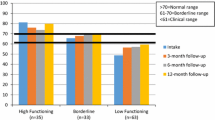Abstract
Pre-treatment and post-treatment data was collected from adolescent clients of a new residential treatment center at Girls and Boys Town. Youth who received treatment improved significantly on the Child Behavior Checklist and the Children's Global Assessment Scale and were maintaining their treatment gains at follow-up. Ten months following discharge, the majority were stabilized and functioning adequately in school and with their primary caregiver. For these youth, residential treatment succeeded where other interventions failed.
Similar content being viewed by others
References
Achenbach, T. M. (1991). Manual for the Child Behavior Checklist/4–18 and 1991 Profïle. Burlington, VT: University of Vermont Department of Psychiatry.
Bates, B. C., English, D. J., & Kouidou-Giles, S. (1997). Residential treatment and its alternatives: A review of the literature. Child & Youth Care Forum, 26, 7-51.
Chang, R., Sanacora, G., & Sanchez, J. R. (1996). The need for outcome studies [letter]. Journal of the American Academy of Child and Adolescent Psychiatry, 35, 557.
Daly, D. L., Schmidt, M. D., Spellman, D. F., Criste, T. R., Dinges, K., & Teare, J. (1998). The Boys Town Residential Treatment Center: Treatment implementation and preliminary outcomes. Child & Youth Care Forum, 17(4), 267-279.
Dowd, T., Herron, R., Hyland, T., & Sterba, M. (Eds.). (1998). Issues in quality child care. Boys Town, NE: Boys Town Press.
Friman, P. C. (1999). Behavioral family-style residential care for troubled out-of-home adolescents: Recent findings. In J. E. Carr & J. Austin (Eds.), Handbook of applied behavior analysis. Reno, NV: Context Press.
Gelles, R. J. (1991). Physical violence, child abuse, and child homicide: A continuum of violence or distinct behavior? Human Nature, 2(1), 59-72.
Hawkins, R. P., Almeida, M. C., Fabry, B., & Reitz, A. L. (1992). A scale to measure restrictiveness of living environments for troubled children and youths. Hospital and Community Psychiatry, 43(1), 54-58.
Lyman, R. D., & Campbell, N. R. (1996). Treating children and adolescents in residential and inpatient settings. Thousand Oaks, CA: Sage.
Pfeiffer, S. I. (1989). Follow-up of children and adolescents treated in psychiatric facilities: A methodology review. The Psychiatric Hospital, 20, 15-20.
Pfeiffer, S. I., & Strzelecki, S. C. (1990). Inpatient psychiatric treatment of children and adolescents: A review of outcome studies. Journal of the American Academy of Child and Adolescent Psychiatry, 29(6), 847-853.
Shaffer, D., Gould, M. S., Brasic, J., Ambrosini, P., Fisher, P., Bird, H., & Aluwahlia, S. A. (1983). A children's global assessment scale (CGAS). Archives of General Psychiatry, 40, 1228-1231.
Sterba, M., Davis, J., & Criste, T. R. (2000). Boys Town's psychoeducational treatment model: A training manual for helping behavioral health professionals care for and treat troubled children and adolescents. Boys Town, NE: Boys Town Press.
Sterba, M., & Dowd, T. (1998). Treating youth with DSM-IV disorders. Boys Town, NE: Boys Town Press.
Weisz, J. R., Han, S. S., & Valeri, S. M. (1997). More of what? Issues raised by the Fort Bragg Study. American Psychologist, 52, 541-545.
Wolf, M. M., Kirigin, K. A., Fixsen, D. L., Blase, K. A., & Braukmann, C. J. (1995). The teaching-family model: A case study in data-based program development and refinement (and dragon wrestling). Journal of Organizational Behavior Management, 15, 11-68.
Author information
Authors and Affiliations
Rights and permissions
About this article
Cite this article
Larzelere, R.E., Dinges, K., Schmidt, M.D. et al. Outcomes of Residential Treatment: A Study of the Adolescent Clients of Girls and Boys Town. Child & Youth Care Forum 30, 175–185 (2001). https://doi.org/10.1023/A:1012236824230
Issue Date:
DOI: https://doi.org/10.1023/A:1012236824230



